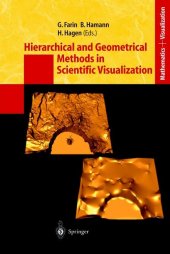 Neuerscheinungen 2012Stand: 2020-01-07 |
Schnellsuche
ISBN/Stichwort/Autor
|
Herderstraße 10
10625 Berlin
Tel.: 030 315 714 16
Fax 030 315 714 14
info@buchspektrum.de |

Gerald Farin, Hans Hagen, Bernd Hamann
(Beteiligte)
Hierarchical and Geometrical Methods in Scientific Visualization
Herausgegeben von Farin, Gerald; Hamann, Bernd; Hagen, Hans
Softcover reprint of the original 1st ed. 2003. 2012. vi, 367 S. VI, 367 p. 235 mm
Verlag/Jahr: SPRINGER, BERLIN 2012
ISBN: 3-642-62801-X (364262801X)
Neue ISBN: 978-3-642-62801-6 (9783642628016)
Preis und Lieferzeit: Bitte klicken
The nature of the physical Universe has been increasingly better understood in recent years, and cosmological concepts have undergone a rapid evolution (see, e.g., [11], [2],or [5]). Although there are alternate theories, it is generally believed that the large-scale relationships and homogeneities that we see can only be explainedby having the universe expand suddenlyin a very early "in?ationary" period. Subsequent evolution of the Universe is described by the Hubble expansion, the observation that the galaxies are ?ying away from each other. We can attribute di?erent rates of this expansion to domination of di?erent cosmological processes, beginning with radiation, evolving to matter domination, and, relatively recently, to vacuum domination (the Cosmological Constant term)[4]. We assume throughout that we will be relying as much as possible on observational data, with simulations used only for limited purposes, e.g., the appearance of the Milky Wayfrom nearbyintergalactic viewpoints. The visualization of large-scale astronomical data sets using?xed, non-interactive animations has a long history. Several books and ?lms exist, ranging from "Cosmic View: The Universe in Forty Jumps" [3] by Kees Boeke to "Powers of 10" [6,13] by Charles and Ray Eames, and the recent Imax ?lm "Cosmic Voyage" [15]. We have added our own contribution [9], "Cosmic Clock," which is an animation based entirely on the concepts and implementation described in this paper.
From the reviews:
"This work ... introduce the first end-to-end multiresolution dataflow strategy that can effectively combine the top performing subdivision-surface wavelet compression and view-dependent optimization methods, thus increasing efficiency by several orders of magnitude over conventional processing pipelines. ... Overall, this is the first effort to exploit semi-structured surface representations for a complete large-data visualization pipeline." (Wordtrade, July, 2008)
Hans Hagen, geboren 1955 in den Niederlanden, liebt das Reisen und lässt sich von fremden Kulturen zu den Geschichten seiner Bücher inspirieren.
Hans Hagen is heading the research group for Computer Graphics and Computer Geometry at the University of Kaiserslautern, Germany, and is Scientific Director of the research lab Intelligent Visualization and Simulation at the German Research Center for Artificial Intelligence (DFKI). His research domains are geometric modeling and scientific visualization.


